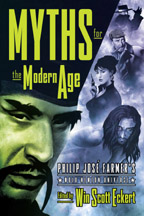
 MYTHS
FOR THE MODERN AGE:
MYTHS
FOR THE MODERN AGE: 
PHILIP JOSÉ FARMER'S WOLD NEWTON UNIVERSE
is now available from MonkeyBrain Books:
In his classic “biographies” of fictional
characters (Tarzan Alive and Doc
Savage: His Apocalyptic Life), Hugo- and
Nebula-award winning author Philip José Farmer
introduced the Wold Newton family, a collection of heroes
and villains whose family-tree includes Sherlock Holmes,
Fu Manchu, Philip Marlowe, and James Bond. In books,
stories, and essays he expanded the concept even further,
adding more branches to the Wold Newton family-tree. MYTHS
FOR THE MODERN AGE: PHILIP JOSÉ FARMER’S WOLD
NEWTON UNIVERSE, edited by Win Scott Eckert,
collects for the first time those rarely-seen essays.
Expanding the family even farther are contributions from
Farmer’s successors—scholars, writers, and
pop-culture historians—who bring even more fictional
characters into the fold.
 format.
To download the Timeline, right-click on the hyperlink and select
"Save Target As..." Due to its length, it may take a
while to download (perhaps 6 or more minutes on a dial-up
connection); please be patient.
format.
To download the Timeline, right-click on the hyperlink and select
"Save Target As..." Due to its length, it may take a
while to download (perhaps 6 or more minutes on a dial-up
connection); please be patient.
